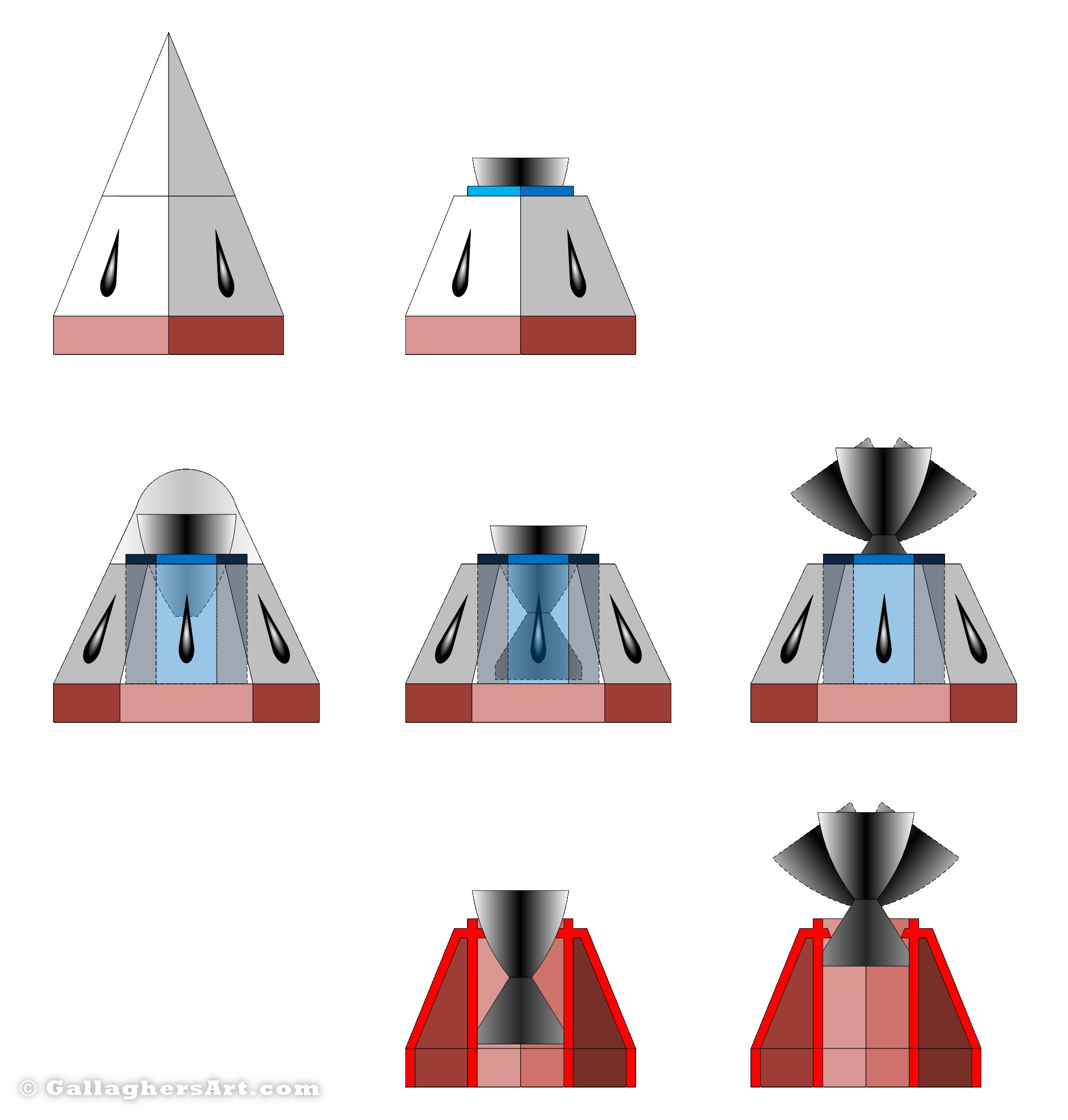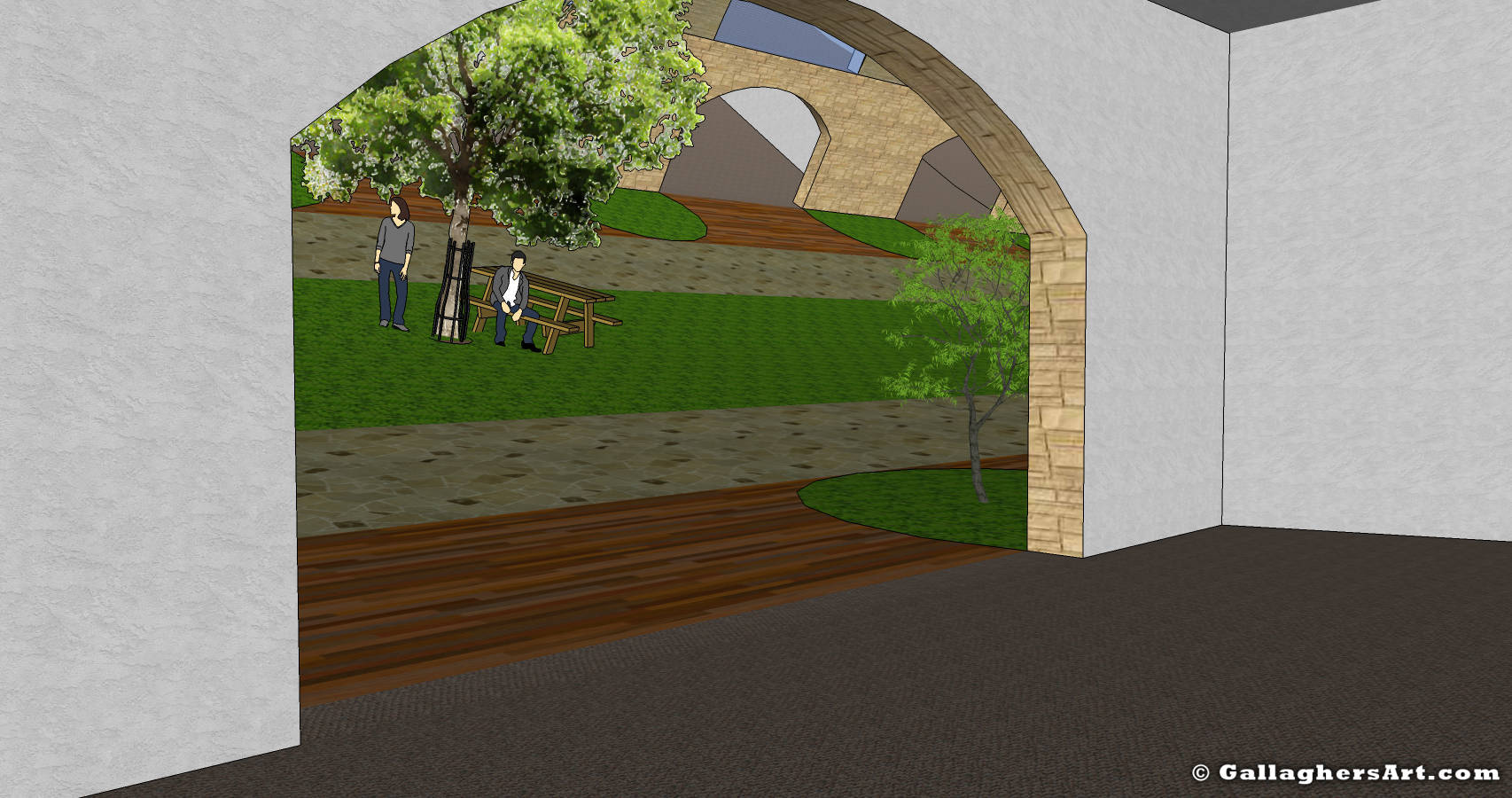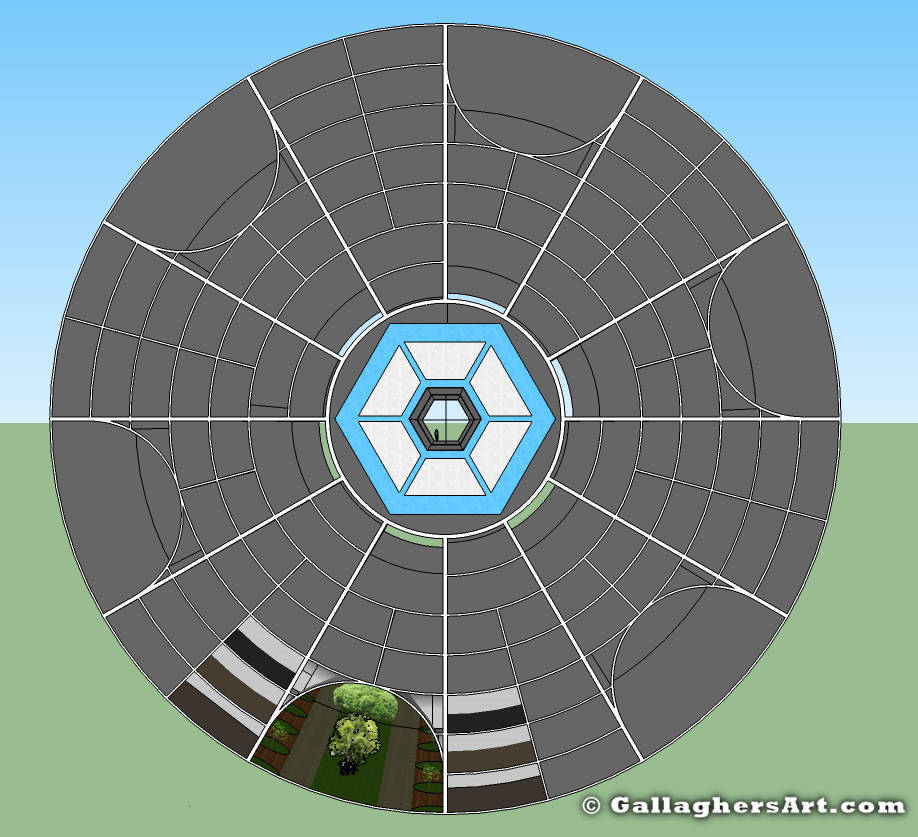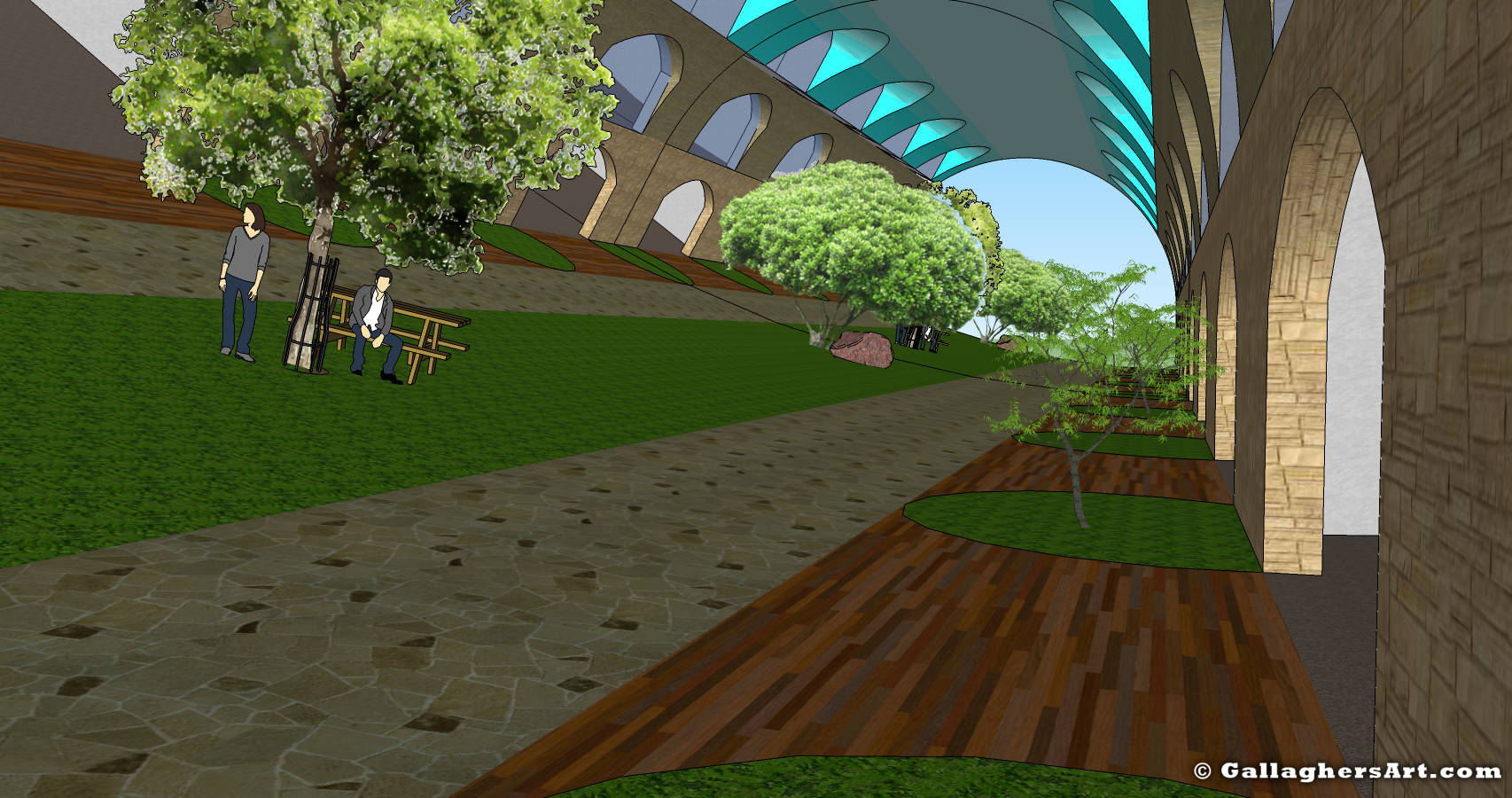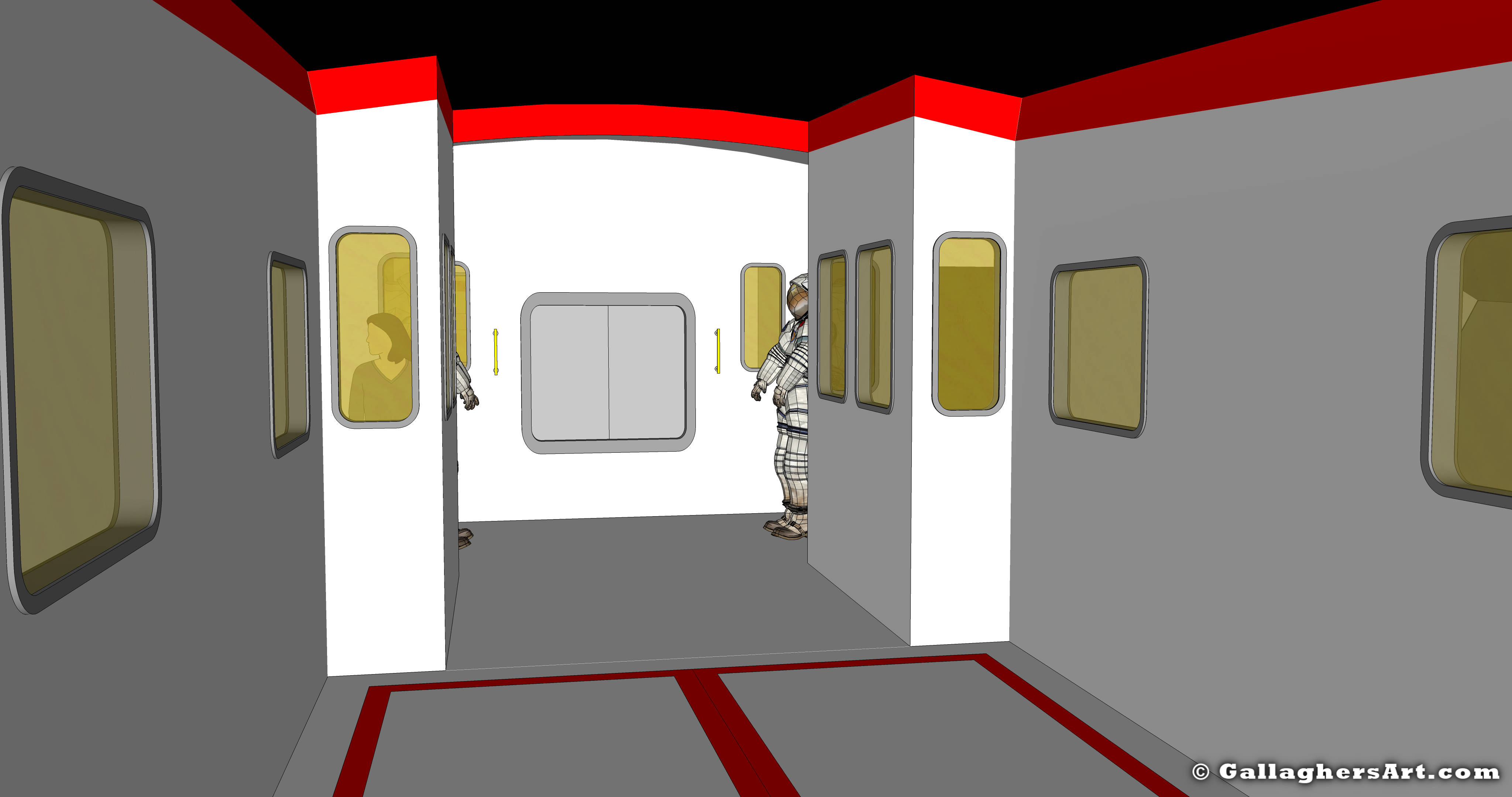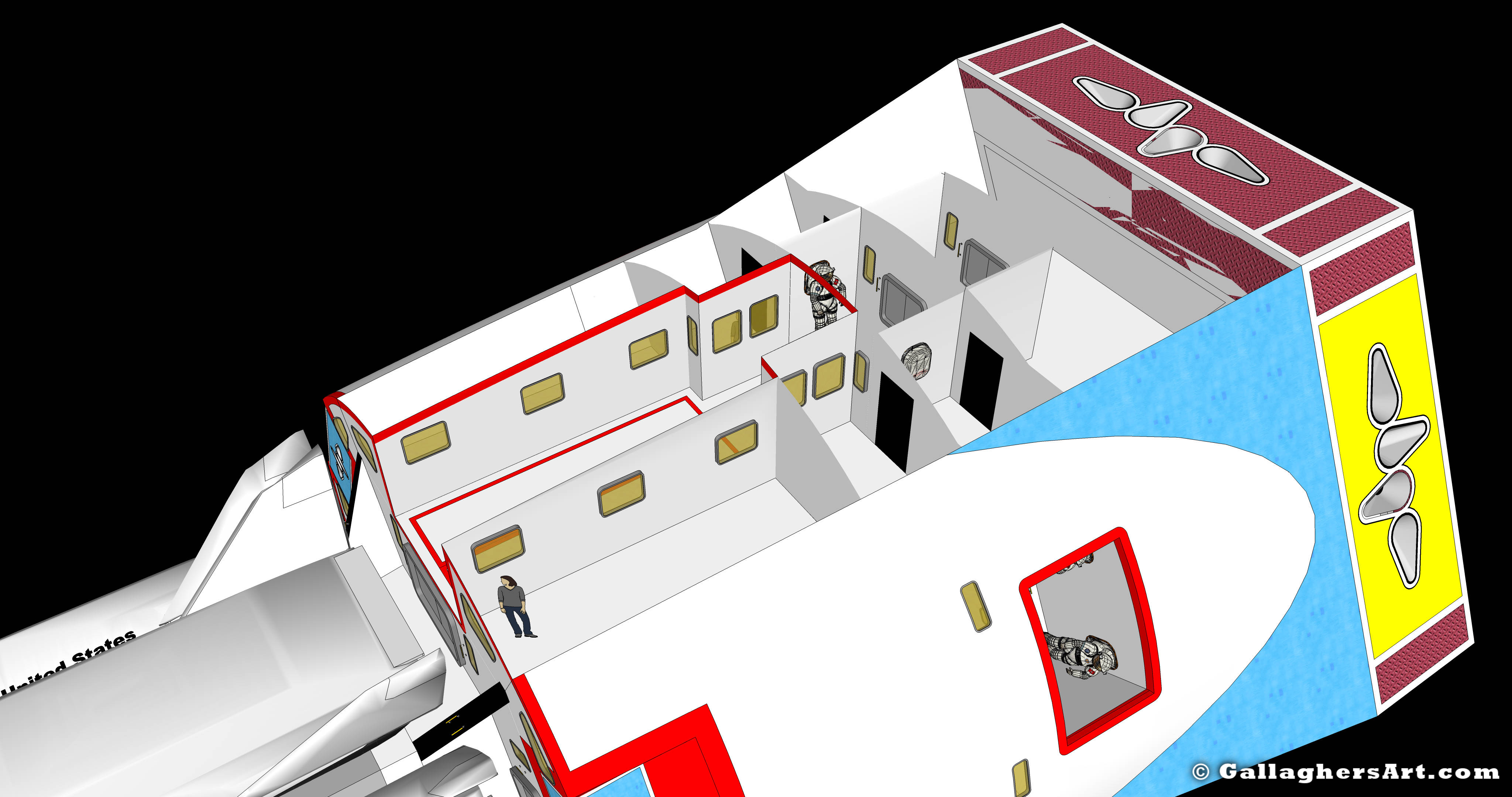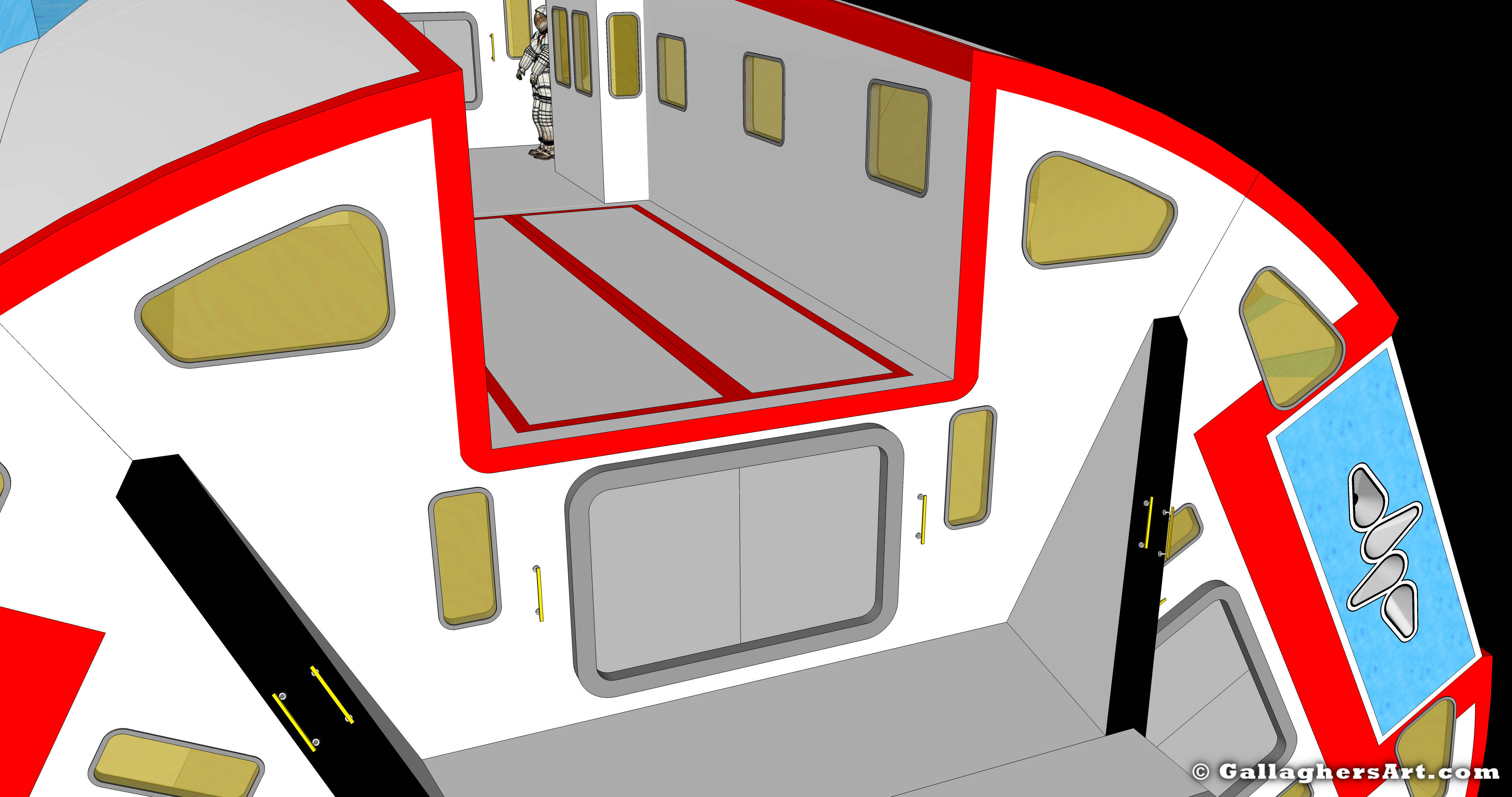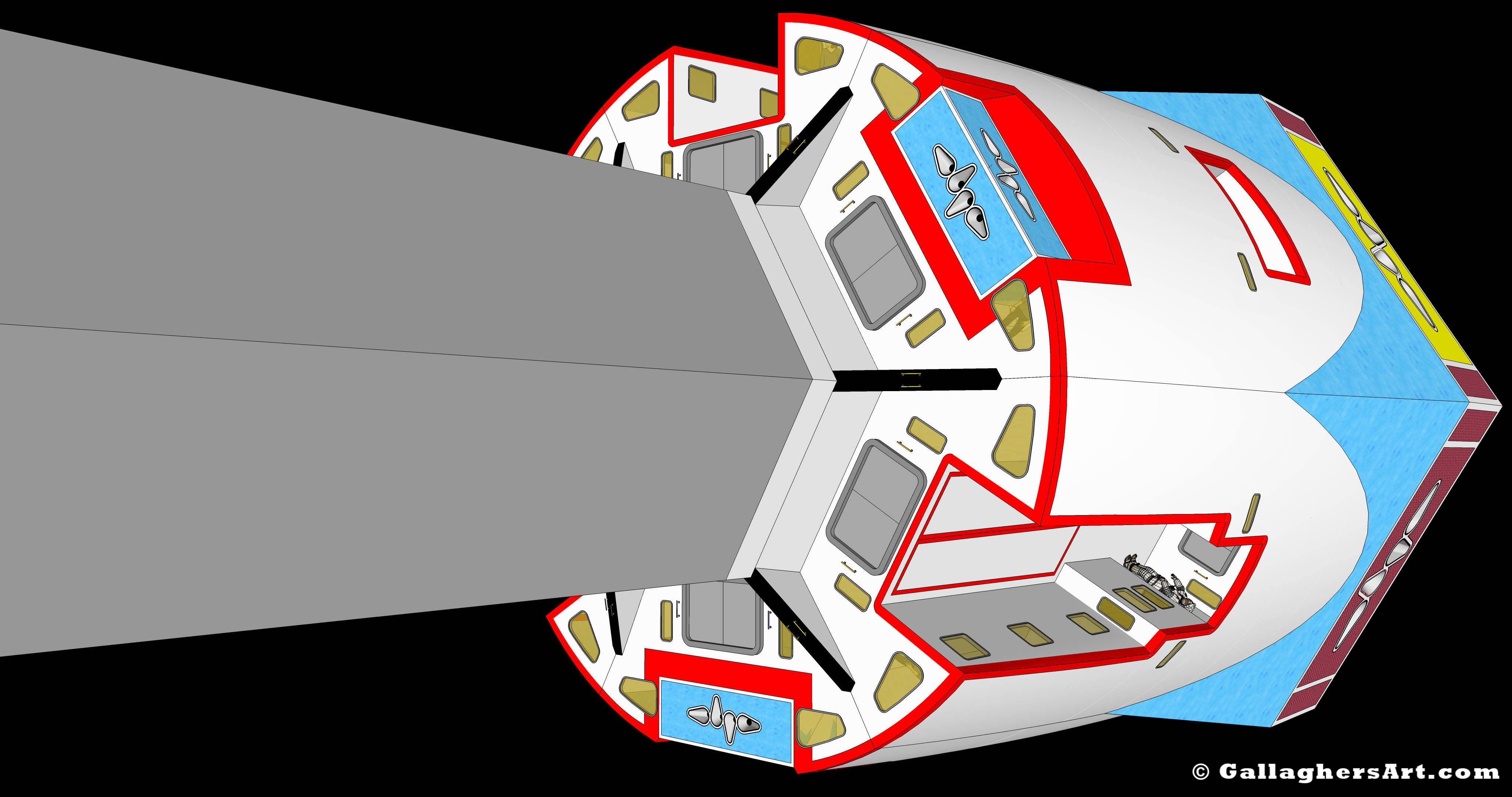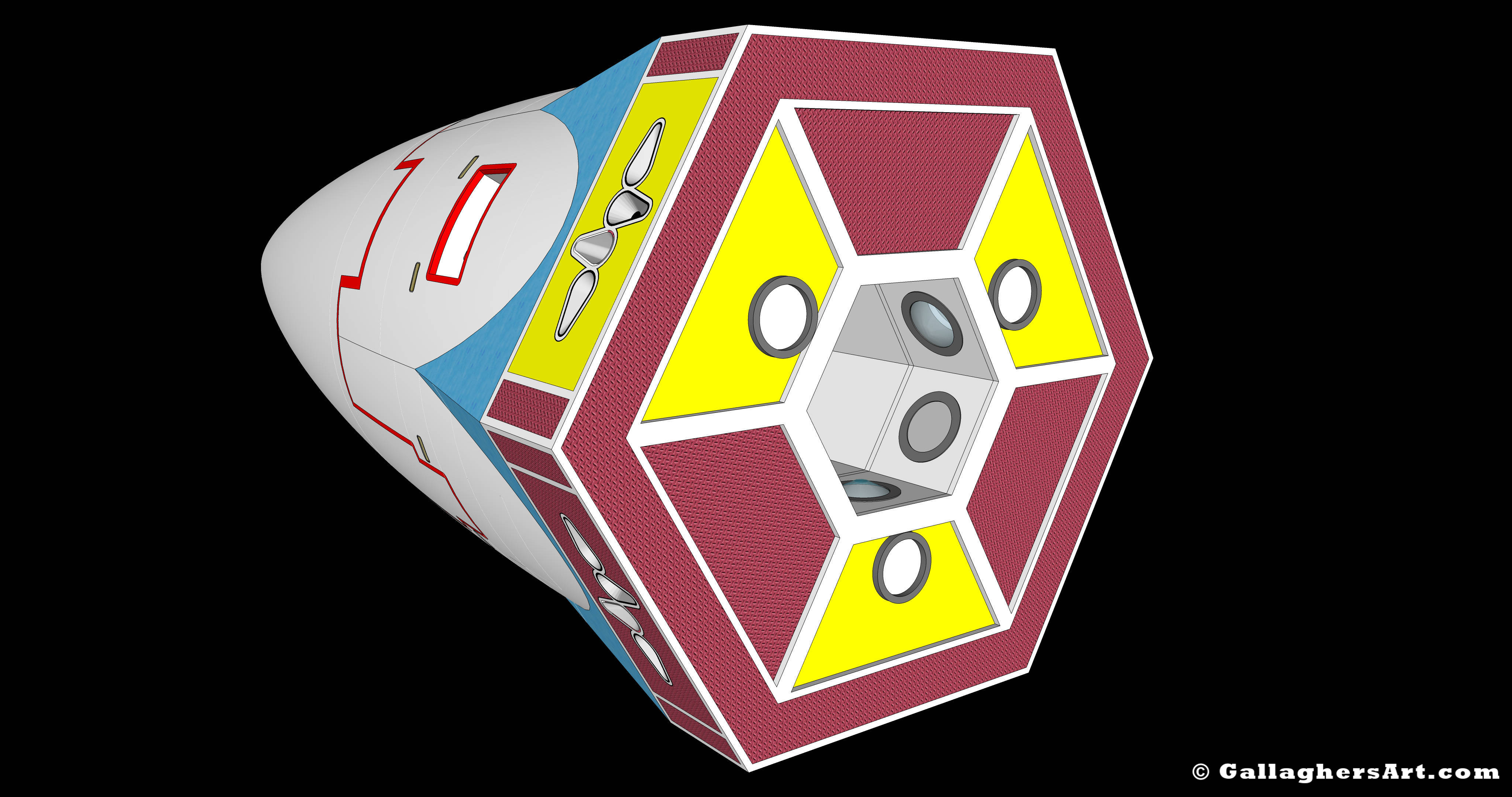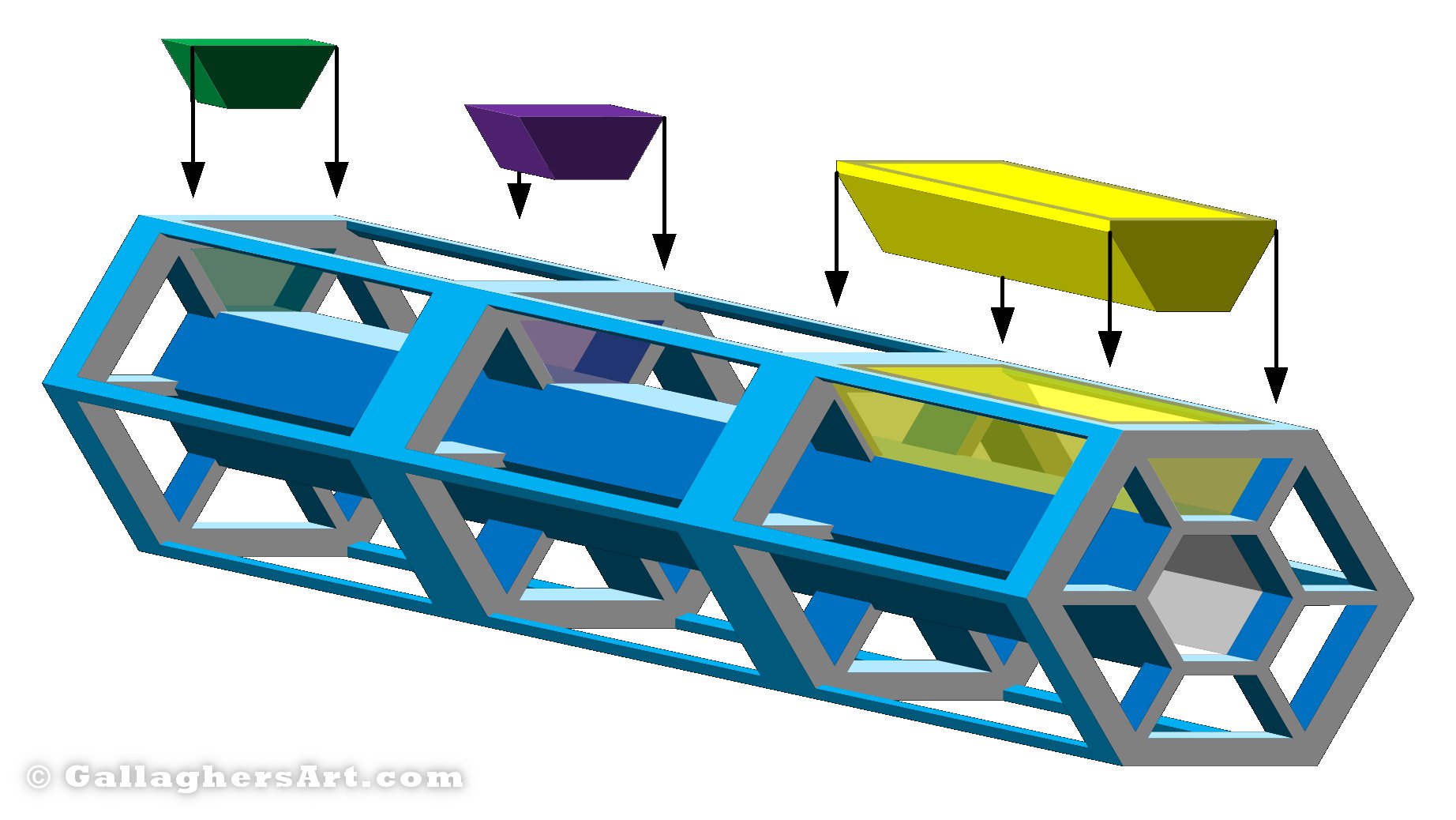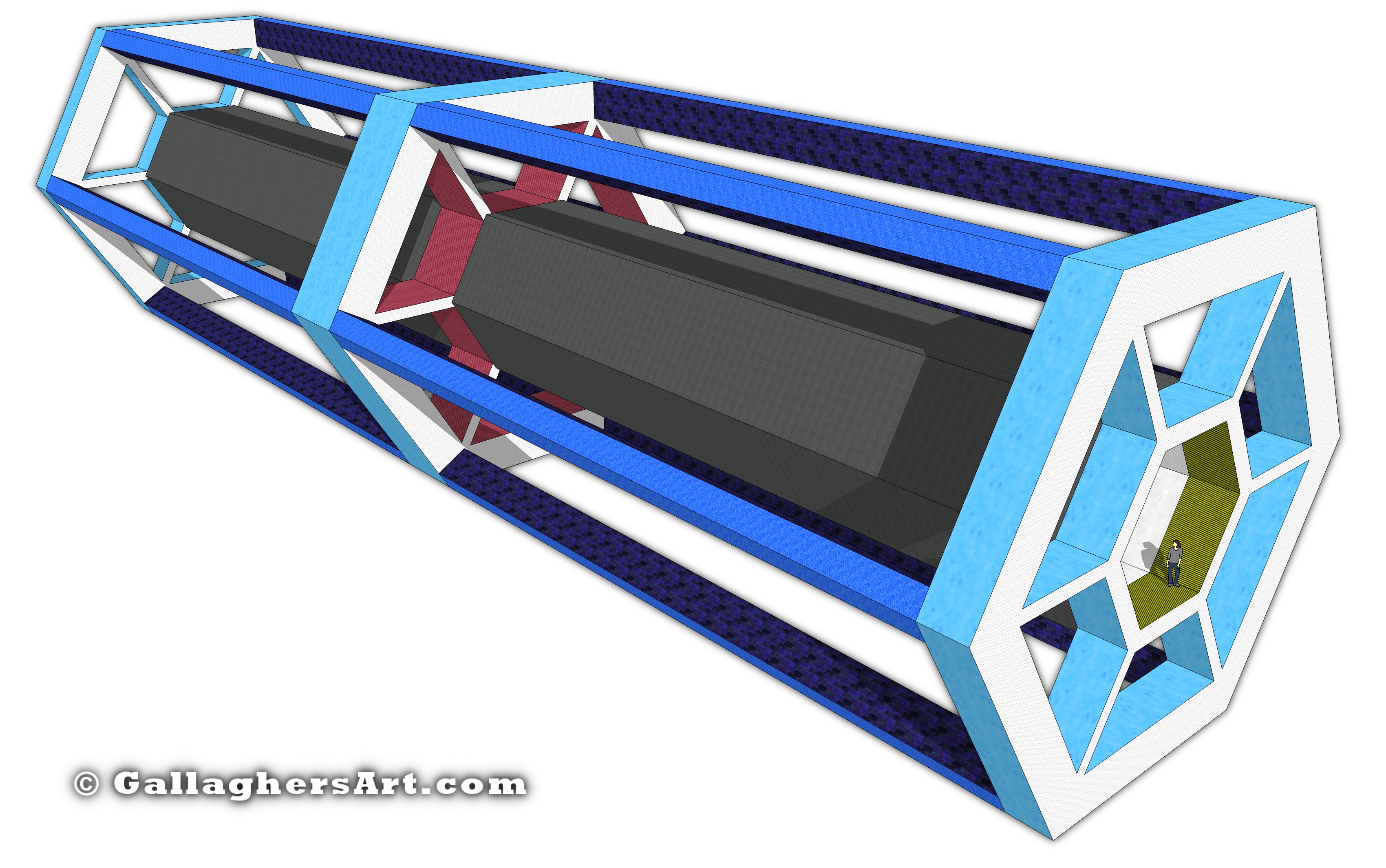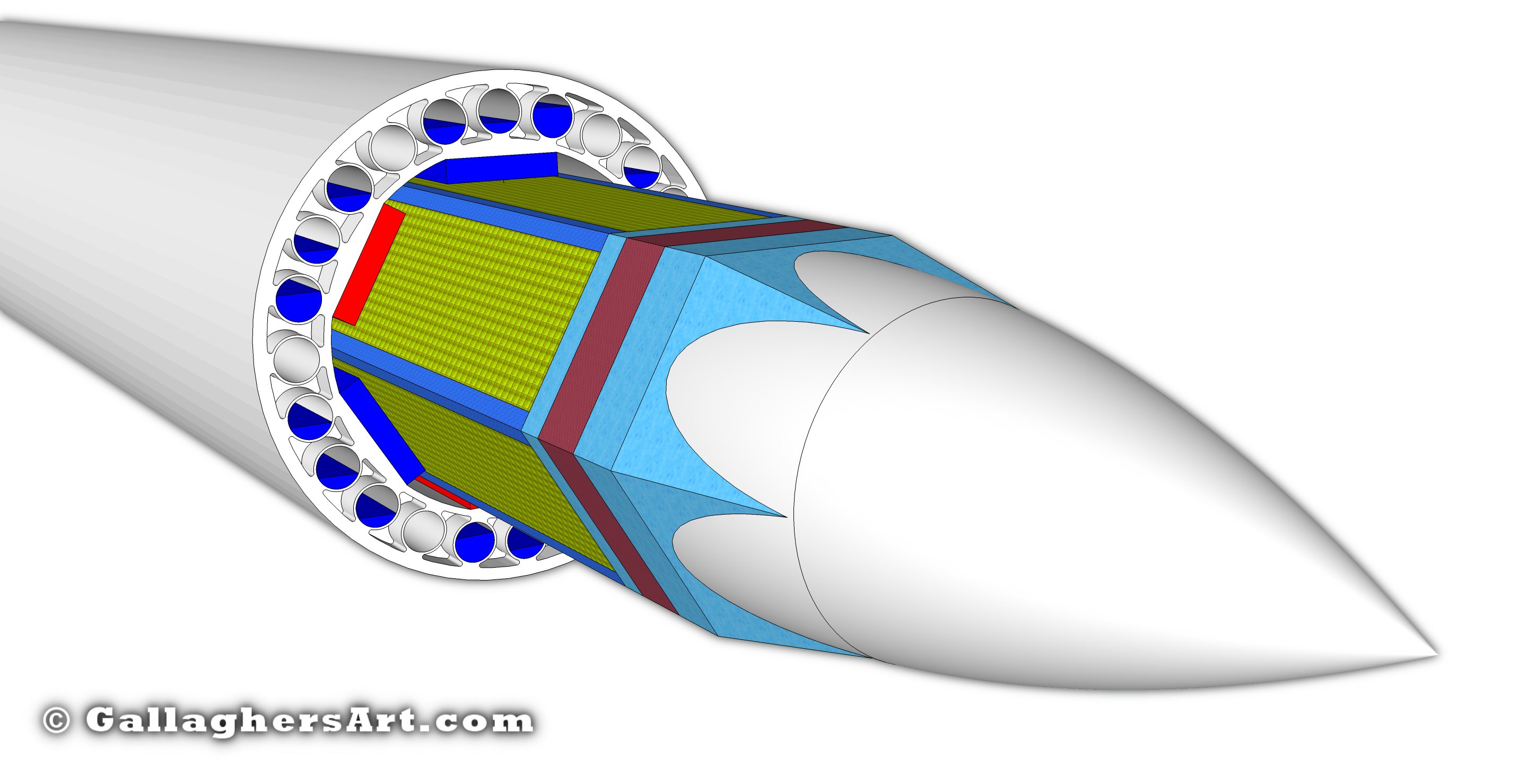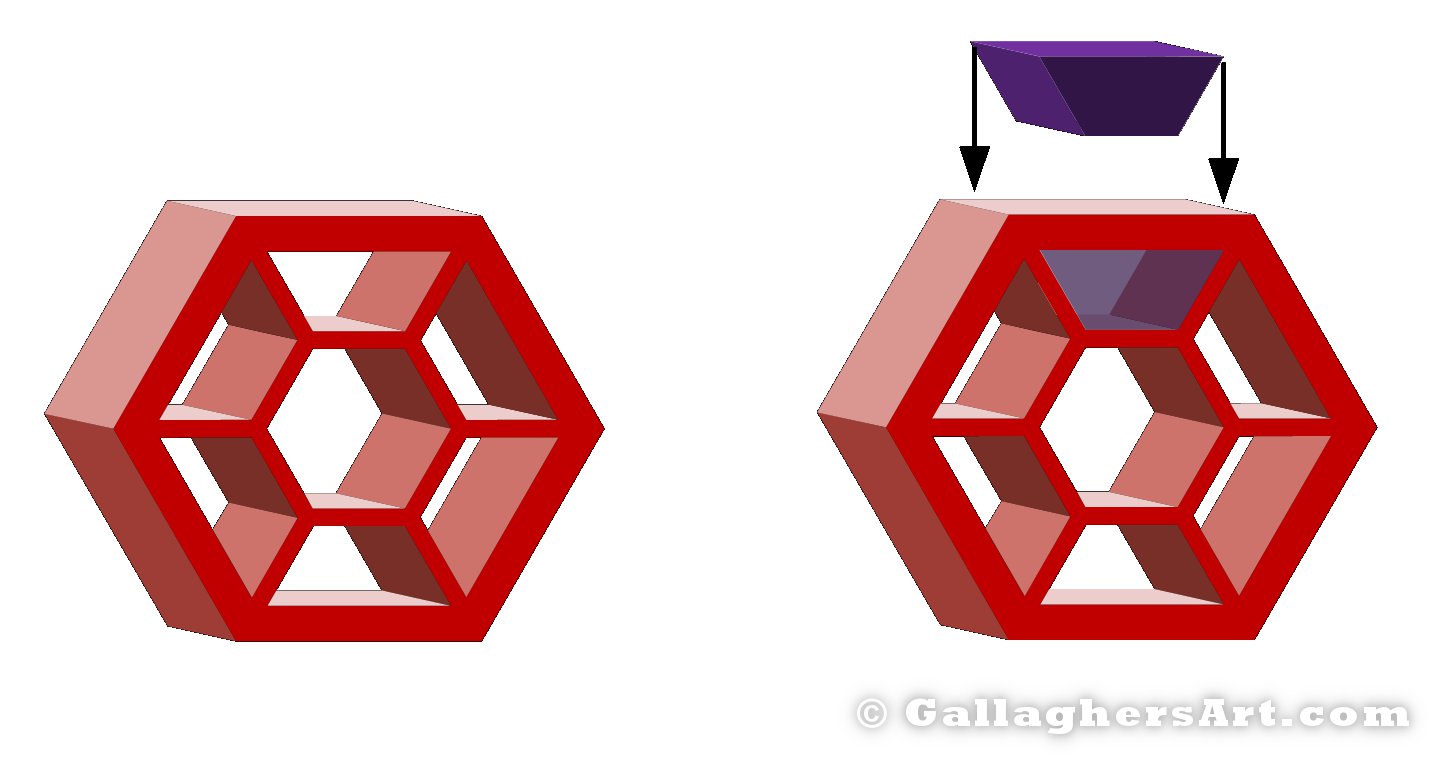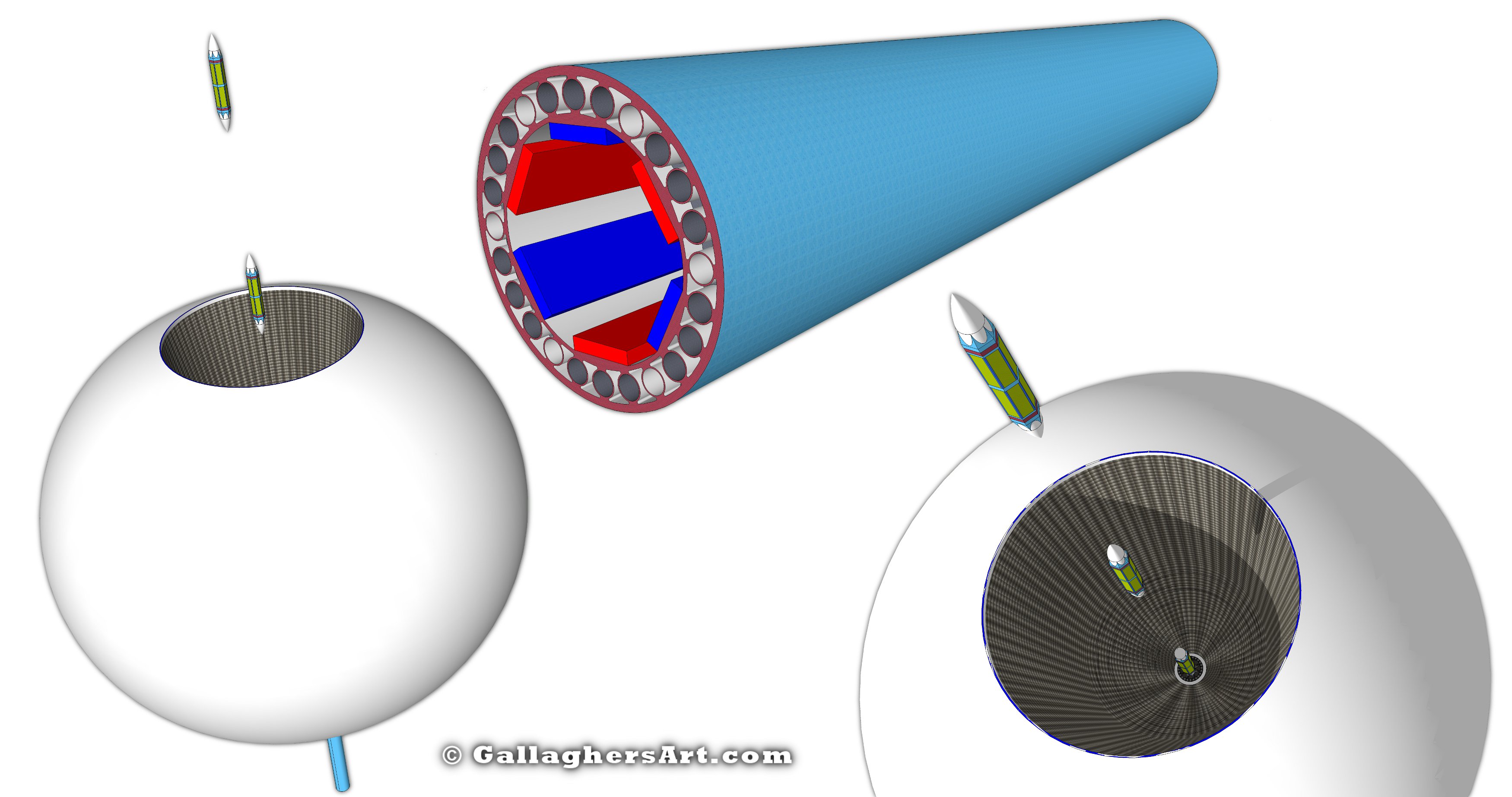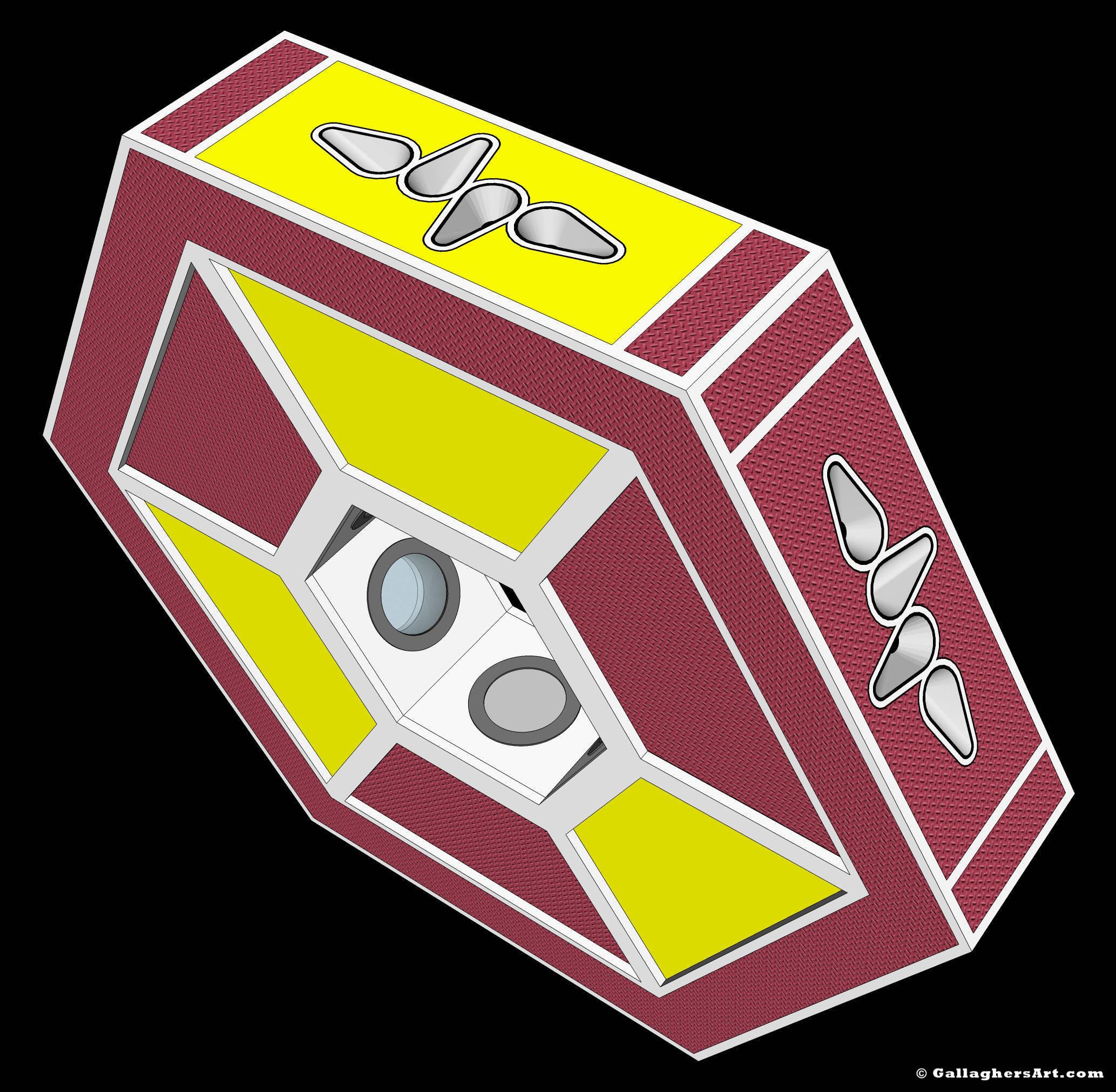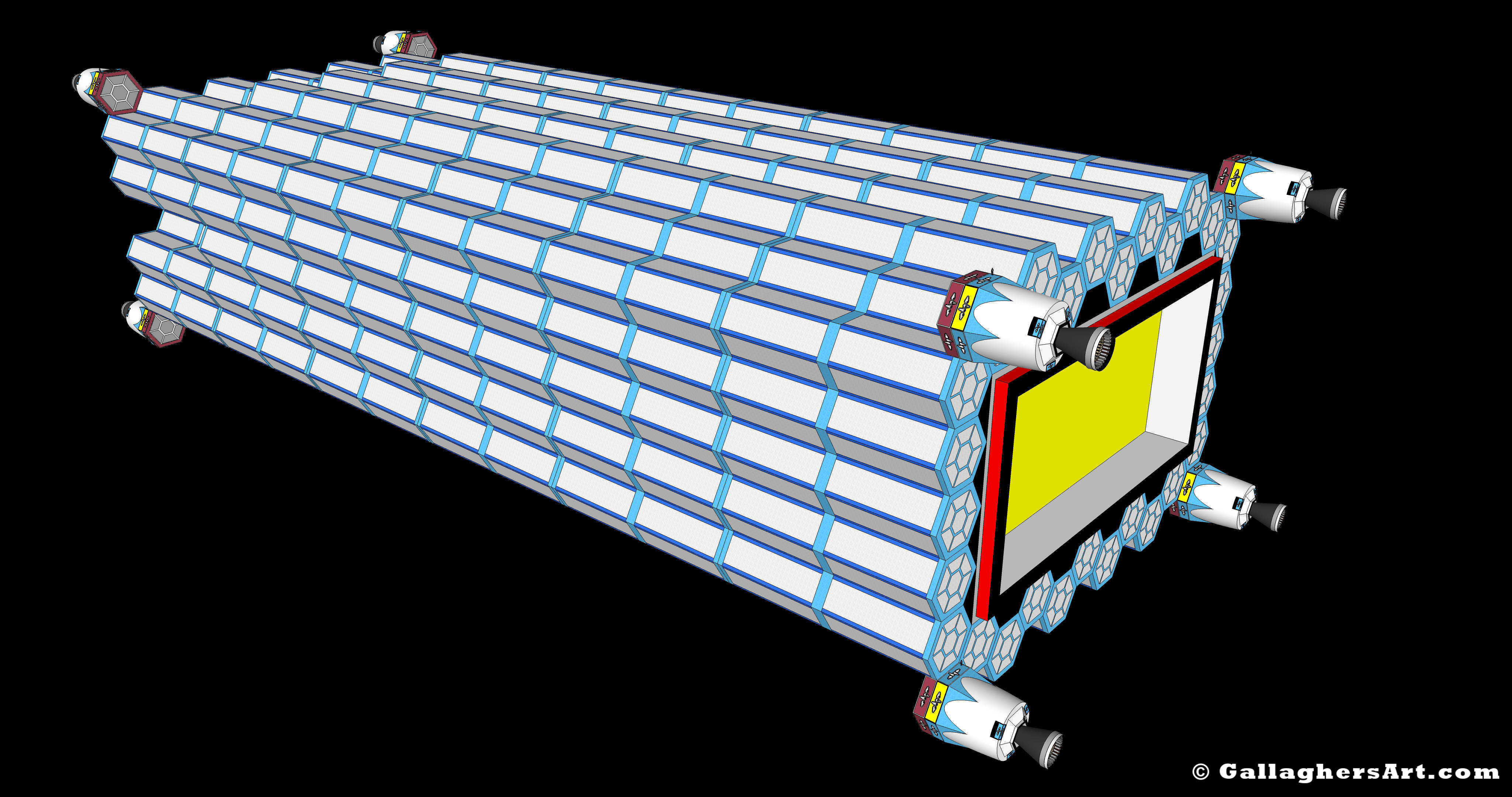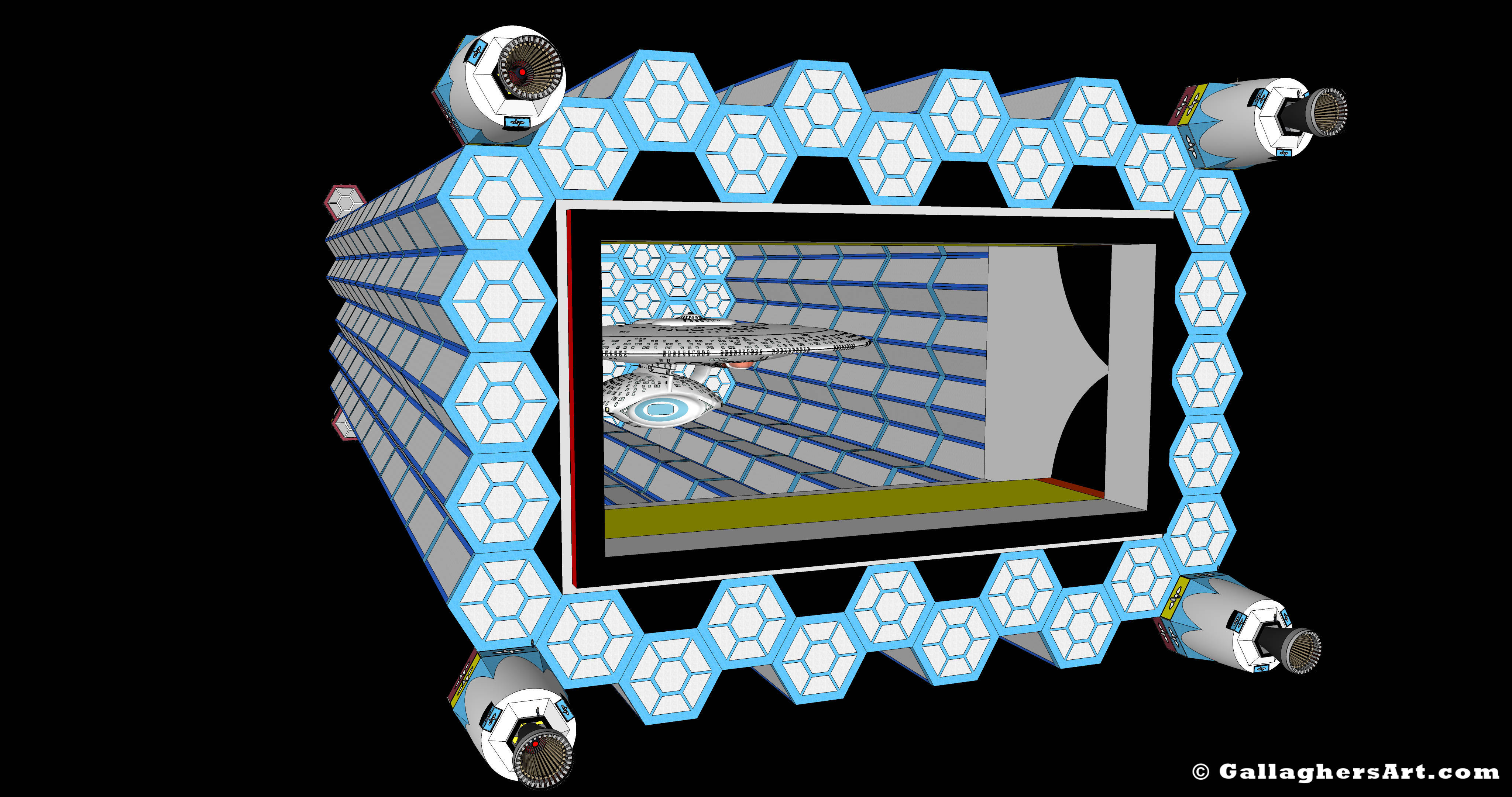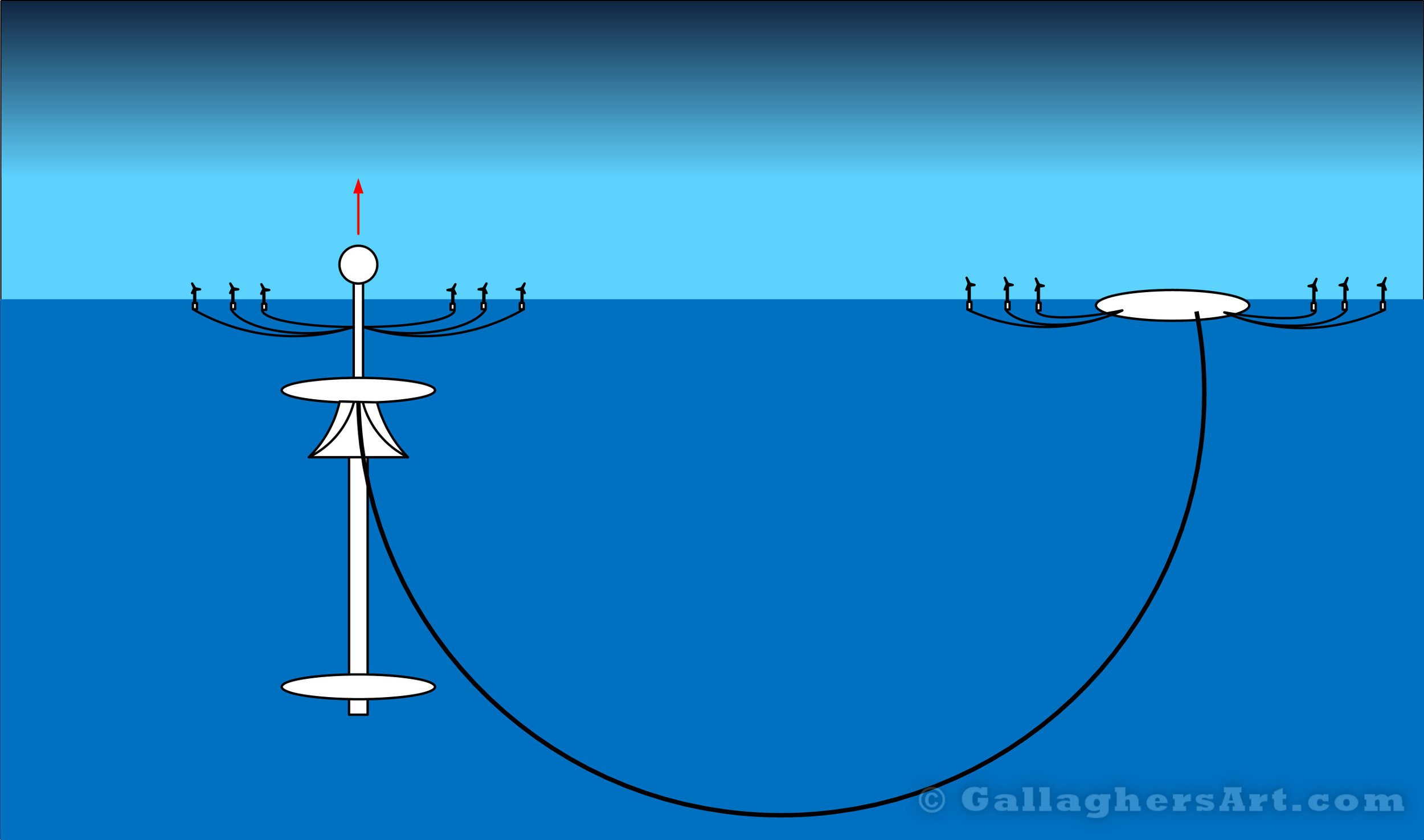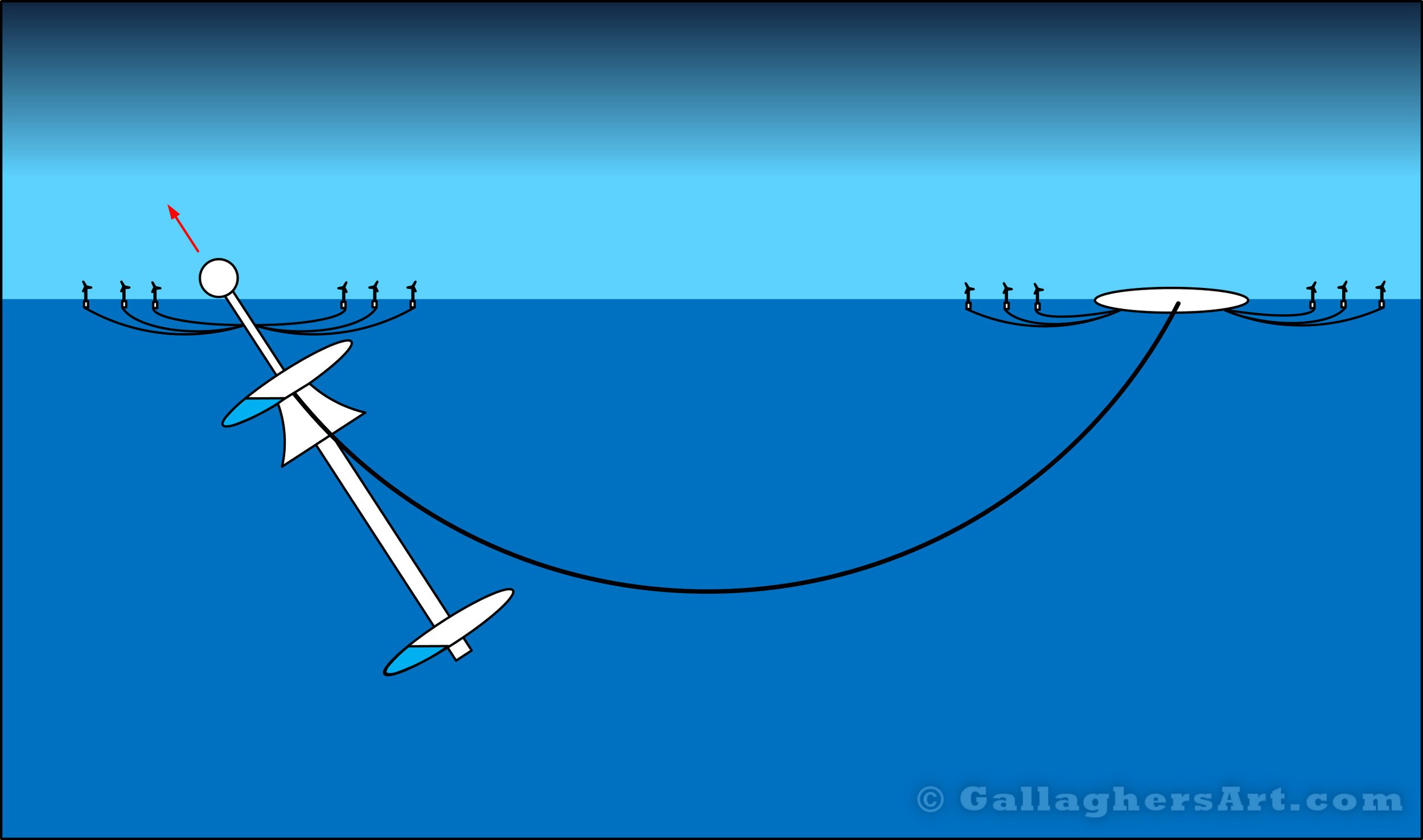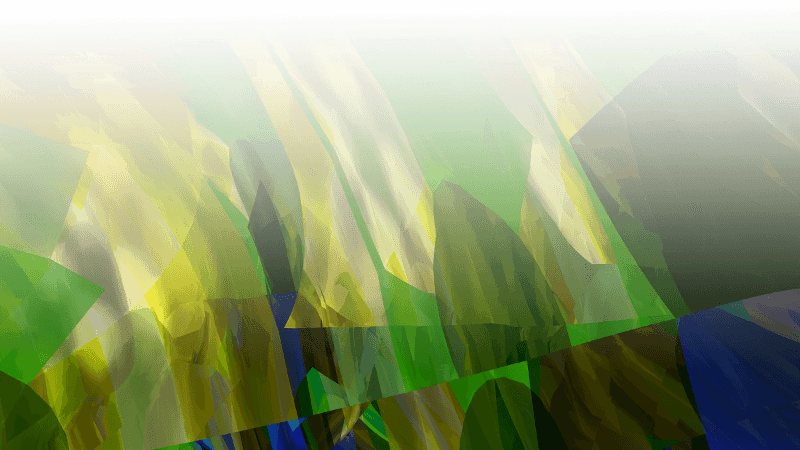

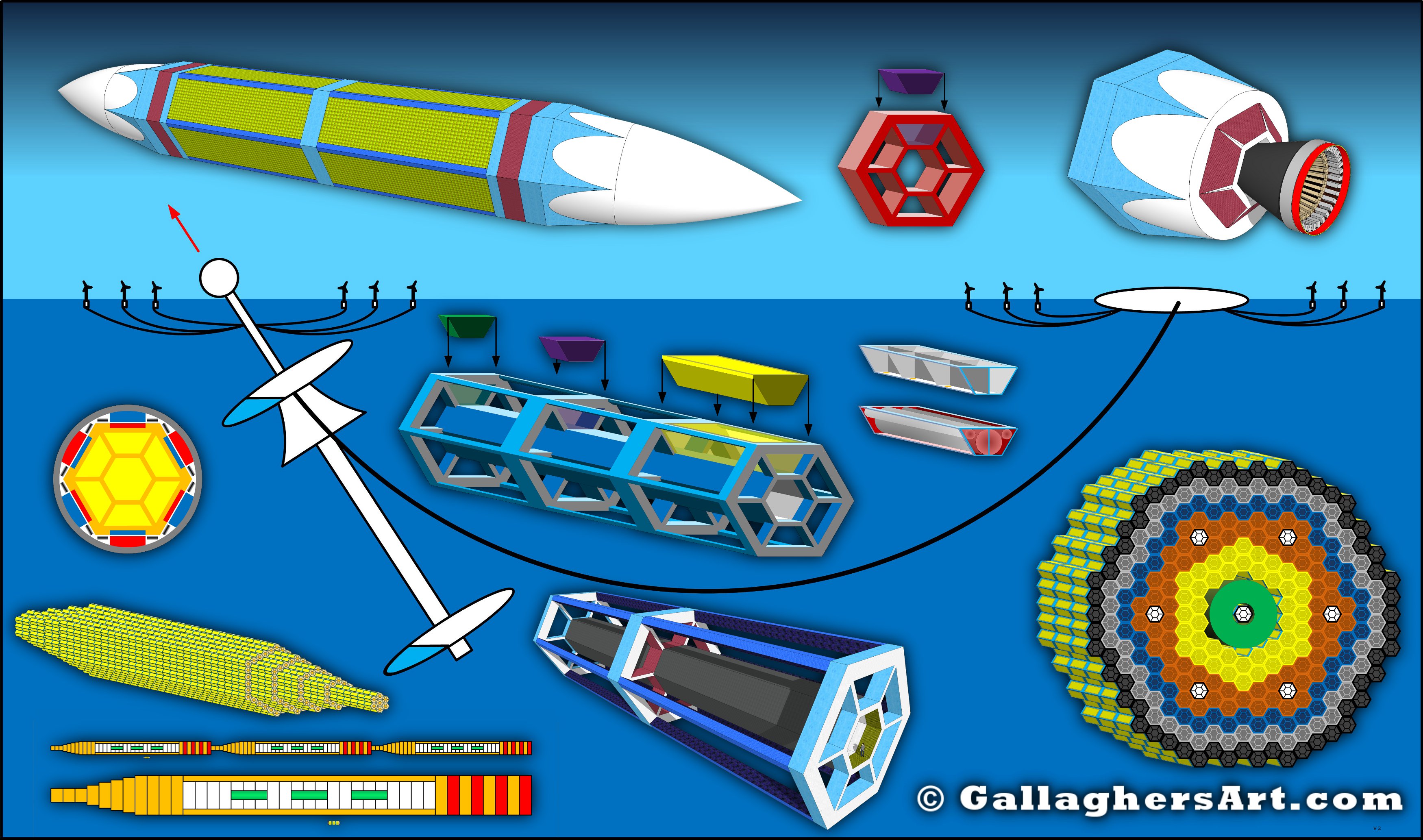
* UPDATED Friday, March 29, 2013: images
* UPDATED Friday, June 15, 2012: images
For humans to travel to distant solar systems and searching for habitable planets to colonize, the past technology used to exit the Earth’s atmosphere is not capable of sending the needed resources with the travelers.
We need a super redundant, modular, system that’s as easy as replacing bad parts as it is to make a LEGO model. All parts should fit together in many different combinations. The whole ship should be able to recycle materials and rebuild any part of the ship. 1,000’s of the same smaller engines cover all sides of the ship; never know when we need to get out of the way.
But mostly we need a new way to get the needed resources to space.
In this article, I will go over my full plan for sending humans on the epic one way 10+’s of thousands of year’s trip.
My Idea of a new system of getting cargo beyond the earth’s gravity consists of many new technologies and would require many new and untested ideas to complete the project.
The system centers around a large 6 sided (well 8 if you counts the ends..) container. Each of the six sides is a flat surface that aligns up with a 6 walled tube. Just like how the maglev trains work, but instead of just using the bottom of the trains, we would use all 6 sides of the Launch Vehicle. And the 6 sides of the tunnel to propel each Launch Vehicle to speeds that would allow it to leave Earth Gravity without any fuel being burnt.
Once past the Earth atmosphere, minimal amounts of flaring would be jettison. And this is where the module part of my design comes in place. At the end of each Container is a service module then a navigation module. Each of these modules can have many uses and configurations.
Each of the navigation modules is cable of networking with other modules and following instructions remotely. Once in space, these modules would direct containers together and robotically build the raw structure from the containers and the containers structures.
The navigation modules become the robotic workers of the space ship being built. Controlled both remotely and able to complete tasks on their own.
These navigation modules can also house main engines, extra storage, and airlock on both ends. In the airlock, version would in fact turn this module into a space ship. As all need life support for the airlocks and navigation systems are part of the module system.
As the final modular Space ship is being built, empty and not needed Launch Vehicle Structures would be placed on the outer most area of the space ship. Along with many placed in the front. Over time these units may protect the inner ship from major disasters.
From there each layer of containers would resemble a sliced onion. Each inner ring of containers would add more and more protection to the inner rings. The outer most rings would have unused and empty containers. Then a spacer area using the no longer needed service modules. This would make a cavity between the outer protection and outer wall of the habitable areas. The idea is for quick and easy sealing of impacts.
So past the outer layers of protection, the core habitable area starts. The first layers are containers totally full of water. This layer would totally surround the inner habitable areas. This is also Extra water, It only uses is to protect against radiation, And ballast for slowing down once at the final destination.
From there we have a few layers of storage that is capable of being in a vacuum and any temperature if needed.
Then we have a few layers in the center with air and heat. All the day to day tasks would be in this area. All the other areas only need to access storage.
A few areas throughout each ship would have most of the inner area opened up. In this cavity a spinning tube that will give its crew some gravity. Each Tube will in fact be several layers of floors for the crew to live in.
Ideally, everything the crew needs to do should be within these areas with gravity. Some of the other habitable containers may have mini tubes that spin to grow food. These tubes would have at one point contained fuel, but now empty they find a new purpose.
And that’s the point, everything has a purpose and when that item is no longer needed for its original purpose we need to find a new use for it. If no direct use is found, the crew would then break it down to base materials. These base materials would then be used to build new items the Ship may need.
Every item on the ship from the containers structures, engines, and even the computer chips needs to be able to be built on the ship. From scratch.
So the big question is how do you get 10’s of thousands of Launch Vehicles that are larger in diameter than the Apollo moon rockets (the base of the rockets, not the crew module). And not to mention the difference in weight. These containers need to act like a lead bullet as they rip through the earth’s atmosphere. The more they weigh the better.
The front and rear navigation modules with aerodynamic flaring are not just for aerodynamics. They also act as a heat shield for exiting the earth atmosphere. I’m sure the trails of several launches at once would appear like roman candles taking up the whole horizon of view.
One drawback is this system is for cargo only, and not meant for direct earth orbit. I envision these launches to be towards the moon or other planets that the launch vehicle would then orbit.
I do have one idea for human launches. While back I heard of a liquid with high oxygen content. That when a person was submerged within this liquid they could breathe it. I suppose a well-structured fish tank filled with this liquid could protect the crew during launch. They would still need a custom made full body harness so no part could be moved. While submerged the extreme g forces may or may not still kill the crew. I would think this would make for not such a fun time for the launch. A person may need to be in this fish tank for days. From the time before launch and time needed to safely remove the crew from these tanks.
Each of these complete launch vehicles includes 2 service modules. 1 at each end between the container and the navigation modules. During the launch, these are the most important parts of the vehicles. On each of the 6 sides of the service, modules contain the magnetic materials need to interact with the walls in the launch tubes. As the vehicles travel through the launch tubes the high power magnets on the walls of the tubes propel the vehicle to speeds that will allow then to exit the Earth gravity.
What’s even better this is all eclectic, and the way things are going I’m sure super large floating wind turbines are just around the corner.
In order for the vehicles to travel at these speeds, the tubes need to be in a vacuum. The containers start their journey under gravity in a vacuum and end free of earth gravity and in the vacuum of space.
My vision is stationed in the middle of the Pacific Ocean with 2 mammoth floating platforms. There may be 100’s of miles between these platforms. But they are connected by the launch tube.
The vacuumed launch tubes are built solid and super strong. But as a whole allow for some flexibility between the two platforms. This flexibility is what will enable the launching at different angles.
The smaller platform is for the loading and final checks for each vehicle. Each unit would be weighed and center of gravity verified, cleaned, and then placed in the magazine’s slots for launch. At this point, the containers are in a vacuum and ready for launch.
This platform will have 3 levels that cycle scheduled drops for each launch. Think of this platform like to old Tommy guns from way back with the huge barrel magazines for bullets. The idea with these 3 levels is to have a continuous flow of launch vehicles for each launch.
The launch vehicles start their journey by being dropped into the tubes magnetic fields. Once the unit is released it will never again have contact with the earth. From this point forward the Launch vehicle is suspended within the magnetic fields of the launch tube.
As the Launch vehicle gains the speed needed to exit the earth gravity the tube will be bending towards the finial launch angle.
And this is why having this built in the middle of the ocean is needed. Each launch can be unique. If this was land-based the launch angle would never change.
Also, the way the floating platforms would be built, no part of the system would be affected by waves.
So we come to what I call the silencer, not really a silencer like for guns. Basically, this whole launch system needs to be in a vacuum to support launches. And once a launch starts the tube will fill up with air rather quickly.
My idea for a solution is to have a reserved vacuumed chamber at the end of the launch tube. Originally I envisioned a sphere. With a single door at the top for launches. But after many years of thinking, I believe the final solution would be a larger sphere with a large hole in it. The hole would be in the shape similar to rocket motor cones. At the bottom of the cone would be the door for the launch tube. Then throughout the sides of this cone will be many doors to this vacuumed sphere.
My thoughts would be the tube will be the last item to lose vacuum. And the area of this cone would be a wave of mixtures going on that may ease the impact of the vehicles impacting the full atmosphere.
From that point, the launch vehicle would just burn its way through the remainder of the earth atmosphere.
Once In space, each of these units would work together to form whatever each launch was meant for.
Throughout the complete cycle for the colonists to reach a new habitual planet their ship may go through several transformations. While their launch vehicle to leave our solar system is being built, all the autonomous containers waiting to be used may form a ship of their own. Then once the ship leaves our solar system the crew will then reconfigure it for the long trip. Then many years from their final destination the ships raw materials may be recycled to build the necessary landing craft and other needed equipment. While jettisoning the extra water for speed reduction.
And that’s why a system of containers that can connect in many different configurations is what is needed.
While in our solar system each container knows its purpose is self-driving. Networking with all other containers as a single mind to navigate each load in the correct order to build the launch vehicle. Each containers groups of navigation and service modules also enable the containers to lock together. Just as current shipping containers connect for ocean shipping. But instead, 8 connections per we would now have 24 connecting points.
The containers frame is what connects to other containers or service and navigation modules. The payload modules may add to the structural integrity but are not designed for that. If the payload modules are removed before placing into the new ship, they may give the ability to build larger rooms. With this design, we could build floors as we are accustomed to now.
For the main launch out from our solar system, I would have all 3 ships be side by side. Then the base of the ships can be built out with all the fuel containers needed. This would also allow the maximum number of engines.
Once the main burn is done all the empty containers would then be placed around the 3 ships for protection. The ships would re-configure to a long line, one behind the other. The idea is if they are going to be traveling through something it will be like a pinhole. And at the same time if something is coming at us the ship would be thin and long. Add that to the fact that each container is its own ship, with its own life support and airlocks. The chances a small meteor destroying the whole ship is less likely. Hopefully, only the containers affected will have problems.
So my idea is basically 3 separate and identical ships that work as one for the whole trip within each ship will be 3 areas capable of gravitation habitation. But only 1 in each ship will be used during the long trip. Once the final arrival nears a baby boom will take place as the ships fill too compactly.
The final transformation may be the largest. At this point, the crew may be 10’s or more years away. They will know what planet they would be landing on and what will be needed to make successful landings. The 3 ships may be cannibalized completely to build the needed landing craft. And depending on the breaking needed to enter the new system, may require another ship configuration.
At this point, it would be up to the current crew to decide how they proceed now at their final destination.
To get these humans to a new solar system would be such a great challenge, many new things would need to be discovered before launch. And continue for the whole trip. Each ship we need to have access to all the same scientific devices and labs as we do on earth. We may have tech that needs another 80 years to finish so let the crew continue on the ship. This would also include containers full of every known material. Even if they do not have a need now. Later some new type of engine or even hibernation technology may rely on this material.
They must be able to retrieve samples from nearby sources during the trip. And along with the ability to mine for fuel and water. God forbid the solar system does not support life. The crew may need to resupply the ship and continue to travel to a new system.
The crew will need to monitor the vitals of personnel, making sure nutrition and genetics do not suffer in any way. Cloning and genetic, and long term egg and sperm storage will need to a normal thing on these ships.
Personally, I can see the same crew members being cloned over and over until the destination. Then the stored genetic material world then be used with the crews to create a larger and stable genetic population.
An even better solution would be a fake womb. Some mechanical device that can carry a fertilized egg to birth. Then we could have a very small crew at any given time. And let’s say something really bad happens and all the crew dies. Once the ship is fixed this device could start a new crew. Talking about having parent issues…
Another required tech would be robotic surgery. And I’m not talking about remote control surgery. Basically once on the robotics table, it does whatever is needed to be done. Medical staff will still always be occupied. But again without, let the robot save the lives. Even though this does not exist yet I believe the current tech will lead to this very shortly. The only real thing lacking has been imagining tech, and that has been exploding in the past few years.
The computer network for these ships will have to be something like we have never seen before. For all, I know we may need to place all electronics is lead enclosures. And even then they may fail. And back to the fault-tolerant thoughts, I would make every container, service, and navigation module have their own triple-redundant shielded computers. Anyone of these could run the whole ship. But all CPU’s work as a single hive and take controls from a central command. I envision a Beowulf computer cluster style use of all the CPUs and BitTorrent design for RAID storage between all CPU’s. As all CPU’s talk to all surrounding them the network would be very fault-tolerant. And in case of loss of signal each and every CPU could become the master as current process are know by all systems. I’m going to have to come back to my thoughts about this part later, too much to discuss.
Also, the phobia of using human waste for fertilizer and reprocessing needs to be overcome. The water that leaves our solar system on these ships will become many different human generations over time. This even goes as for the disposal of dead people. Each person holds a lot of water and many types of minerals and such. Could freeze-dry then grind up to retrieve the minerals. Seems sick to think about, but think about this. There could be 10’s of thousands of crew members during the whole trip. If we buried every crew to space then the number of resources left may not cover the trip.
These ships are 100% recyclable, including the crew.
These ships will see all sorts of disasters and issues throughout the trip. And the redundant design is what I believe will enable this trip to succeed.
All parts of the ship design and build must fit through the single-sized airlocks that take up the ship. So in case many years down the road the crew needs to remove a full container from the middle of the ship. This whole container and structure can be taken apart piece by piece. And moved to a new location or put in storage. The only part not able to travel through the airlocks is the main engine’s cones.
The habitable areas with gravity can also be used to create electricity. Using magnetic bearing the spinning tube is floating within the ship. Throughout will be bicycles that the crews use to spin the tube. And when needed magnets connected to the ship will move into place. With the magnets on the sides of the tubes, the crew will create electricity. Along with keeping the crew fit.
Food processing would go to new levels of tech. currently, my thoughts are on a form of allege that makes oxygen and can be used as protein. This new algae protein would take a place as Soy has. The main byproduct would be the removal of CO2 and the creation of oxygen.
Other Plants and food would also be grown or made. The need to find a food that produces the most oxygen, most protein and with the least amount of waste. An even better choice would be to find something useful for a given plants waste.
I do not see livestock being raised on these ships. But if the mechanical womb works, maybe once every so often the crew can have some bacon.
But that could answer another problem. Pigs eat anything and the crew may find they cannot get rid of every table scrap or organic waste. We can process this so the pigs finish everything.
My other current solution for the last bit of organic waste was to process it for a small fish farm. The fish wastewater would then feed the grow rooms plants. Then the byproduct would be fish meat.
More to come when I get time…


